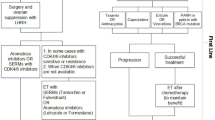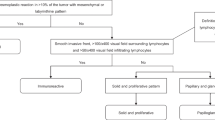Abstract
Background
A gender disparity exists with respect to the incidence of papillary thyroid cancer (PTC), suggesting that sex hormones such as estrogen play a role in PTC development and progression. In this study, we compared estrogen receptor gene expression patterns in PTCs to determine the clinical significance of estrogen gene expression in PTC.
Methods
We analyzed ESR1 and ESR2 messenger RNA expression counts using data from The Cancer Genome Atlas (TCGA). To validate the results of TCGA analysis, we analyzed microarray data (GSE 54958) from the Gene Expression Omnibus.
Results
ESR1 gene expression and ESR ratio (ESR1/ESR2) were significantly higher in PTC tissues than in paired normal thyroid tissues (mean 659.427 vs. 264.045 for ESR1, 92.017 vs. 19.064 for ESR ratio). Among female patients, ESR1 expression and ESR ratio were negatively correlated with increased age. ESR1 expression and ESR ratio were higher in patients with classic PTC, lymphovascular invasion, BRAF V600E mutation, and radioiodine therapy. Classification analysis demonstrated that higher ESR1 expression and a higher ESR ratio faced a worse overall survival (hazard ratio 6.348 for ESR1, 4.031 for ESR ratio). Validation microarray analysis demonstrated that ESR1 expression and ESR ratio were higher in tumor tissues, classic PTC, and BRAF V600E.
Conclusion
Higher ESR1 expression and a higher ESR ratio were associated with aggressive prognostic factors and worse overall survival in female PTC patients. Our results suggest that ESR1 and ESR ratio can be used as prognostic markers to predict female patient survival and have potential as a therapeutic target.
Similar content being viewed by others
References
National Cancer Institute. SEER: Surveillance, Epidemiology, and End Results Program. Available at: www.seer.cancer.gov.
Pellegriti G, Frasca F, Regalbuto C, Squatrito S, Vigneri R. Worldwide increasing incidence of thyroid cancer: update on epidemiology and risk factors. J Cancer Epidemiol. 2013;2013:965212.
Ferlay J, Soerjomataram I, Dikshit R, et al. Cancer incidence and mortality worldwide: sources, methods and major patterns in GLOBOCAN 2012. Int J Cancer. 2015;136:E359–86.
Chen GG, Vlantis AC, Zeng Q, van Hasselt CA. Regulation of cell growth by estrogen signaling and potential targets in thyroid cancer. Curr Cancer Drug Targets. 2008;8:367–77.
Manole D, Schildknecht B, Gosnell B, Adams E, Derwahl M. Estrogen promotes growth of human thyroid tumor cells by different molecular mechanisms. J Clin Endocrinol Metab. 2001;86:1072–77.
Lee ML, Chen GG, Vlantis AC, Tse GM, Leung BC, van Hasselt CA. Induction of thyroid papillary carcinoma cell proliferation by estrogen is associated with an altered expression of Bcl-xL. Cancer J. 2005;11:113–21.
Santin AP, Furlanetto TW. Role of estrogen in thyroid function and growth regulation. J Thyroid Res. 2011;2011:875125.
Zeng Q, Chen G, Vlantis A, Tse G, van Hasselt C. The contributions of oestrogen receptor isoforms to the development of papillary and anaplastic thyroid carcinomas. J Pathol. 2008;214:425–33.
Dong W, Zhang H, Li J, et al. Estrogen induces metastatic potential of papillary thyroid cancer cells through estrogen receptor α and β. Int J Endocrinol. 2013;2013:941568.
Vannucchi G, De Leo S, Perrino M, et al. Impact of estrogen and progesterone receptor expression on the clinical and molecular features of papillary thyroid cancer. Eur J Endocrinol. 2015;173:29–36.
Huang Y, Dong W, Li J, Zhang H, Shan Z, Teng W. Differential expression patterns and clinical significance of estrogen receptor-α and β in papillary thyroid carcinoma. BMC Cancer. 2014;14:383.
Schulten HJ, Alotibi R, Al-Ahmadi A, et al. Effect of BRAF mutational status on expression profiles in conventional papillary thyroid carcinomas. BMC Genomics. 2015; 6(1):S6.
Schulten HJ, Al-Mansouri Z, Baghallab I, et al. Comparison of microarray expression profiles between follicular variant of papillary thyroid carcinomas and follicular adenomas of the thyroid. BMC Genomics. 2015;16(1):S7.
Sing T, Sander O, Beerenwinkel N, Lengauer T. ROCR: visualizing classifier performance in R. BioInformatics. 2005;21:3940–41.
Therneau T, Atkinson B, Ripley B. rpart: recursive partitioning and regression trees. R Package Version 4.1-10, 2015.
R Core Team. R: A language and environment for statistical computing. Vienna, Austria: R Foundation for Statistical Computing; 2015.
Heldring N, Pike A, Andersson S, et al. Estrogen receptors: how do they signal and what are their targets. Physiol Rev. 2007;87:905–31.
Kavanagh DO, McIlroy M, Myers E, et al. The role of oestrogen receptor α in human thyroid cancer: contributions from coregulatory proteins and the tyrosine kinase receptor HER2. Endocr Relat Cancer. 2010;17:255–64.
Di Vito M, De Santis E, Perrone GA, et al. Overexpression of estrogen receptor-α in human papillary thyroid carcinomas studied by laser- capture microdissection and molecular biology. Cancer Sci. 2011;102:1921–27.
Yip L, Nikiforova MN, Carty SE, et al. Optimizing surgical treatment of papillary thyroid carcinoma associated with braf mutation. Surgery. 2009;146:1215–23.
Jonklaas J, Nogueras-Gonzalez G, Munsell M, et al. The impact of age and gender on papillary thyroid cancer survival. J Clin Endocrinol Metab. 2012;97:E878–87.
Disclosures
Jin Wook Yi, Su-jin Kim, Jong Kyu Kim, Chan Yong Seong, Hyeong Won Yu, Young Jun Chai, June Young Choi, and Kyu Eun Lee have no disclosures to declare.
Author information
Authors and Affiliations
Corresponding author
Electronic supplementary material
Below is the link to the electronic supplementary material.
10434_2017_5780_MOESM6_ESM.tiff
Correlation plot between ESR1 mRNA and ER-α protein expression. (A) ESR1 mRNA versus ER-α-RV (B) ESR1 mRNA versus ER-α-pS118-RV. Supplementary material 6 (TIFF 1777 kb)
10434_2017_5780_MOESM7_ESM.tif
Overall survival in the lower and higher gene expression groups, as determined using the Kaplan–Meier method. (A) Survival difference according to ESR1 gene expression levels (B) Survival difference according to ESR ratio. Supplementary material 7 (TIFF 3770 kb)
Rights and permissions
About this article
Cite this article
Yi, J.W., Kim, Sj., Kim, J.K. et al. Upregulation of the ESR1 Gene and ESR Ratio (ESR1/ESR2) is Associated with a Worse Prognosis in Papillary Thyroid Carcinoma: The Impact of the Estrogen Receptor α/β Expression on Clinical Outcomes in Papillary Thyroid Carcinoma Patients. Ann Surg Oncol 24, 3754–3762 (2017). https://doi.org/10.1245/s10434-017-5780-z
Received:
Published:
Issue Date:
DOI: https://doi.org/10.1245/s10434-017-5780-z




